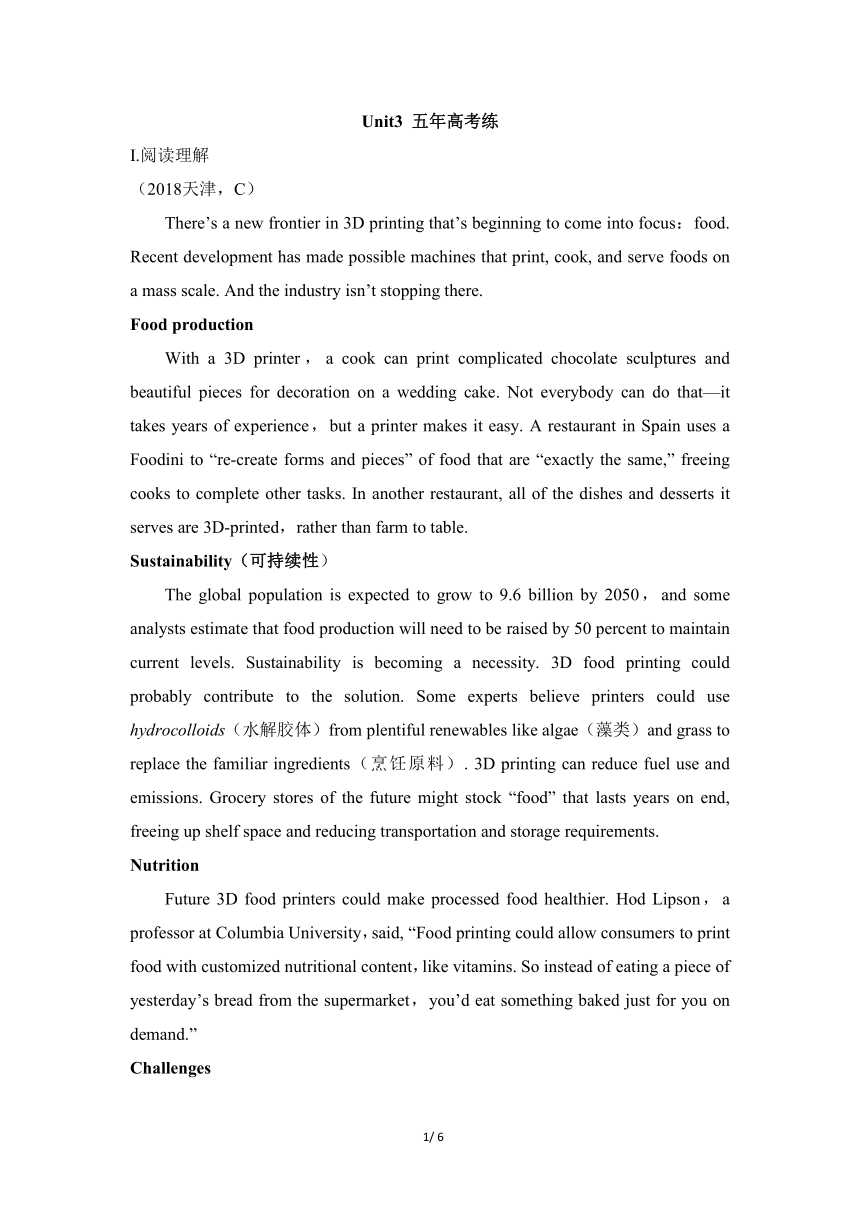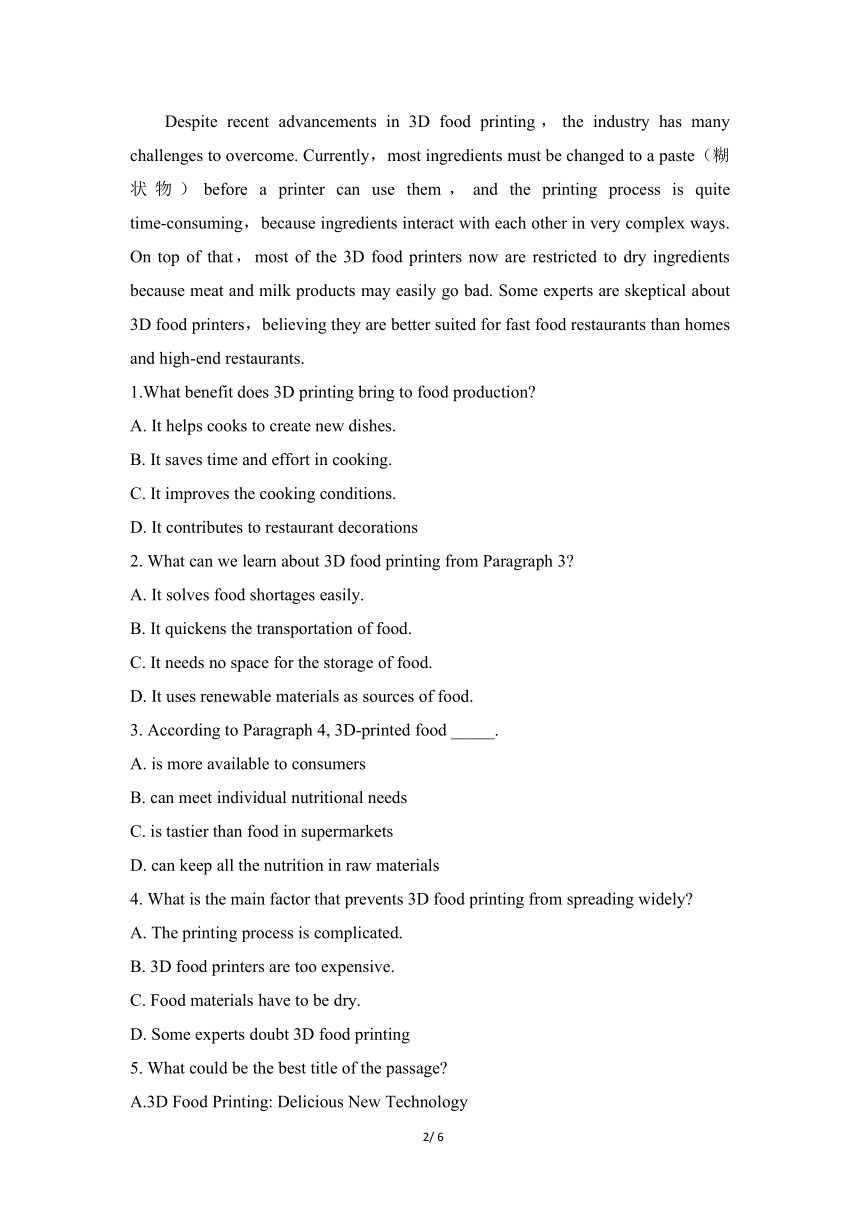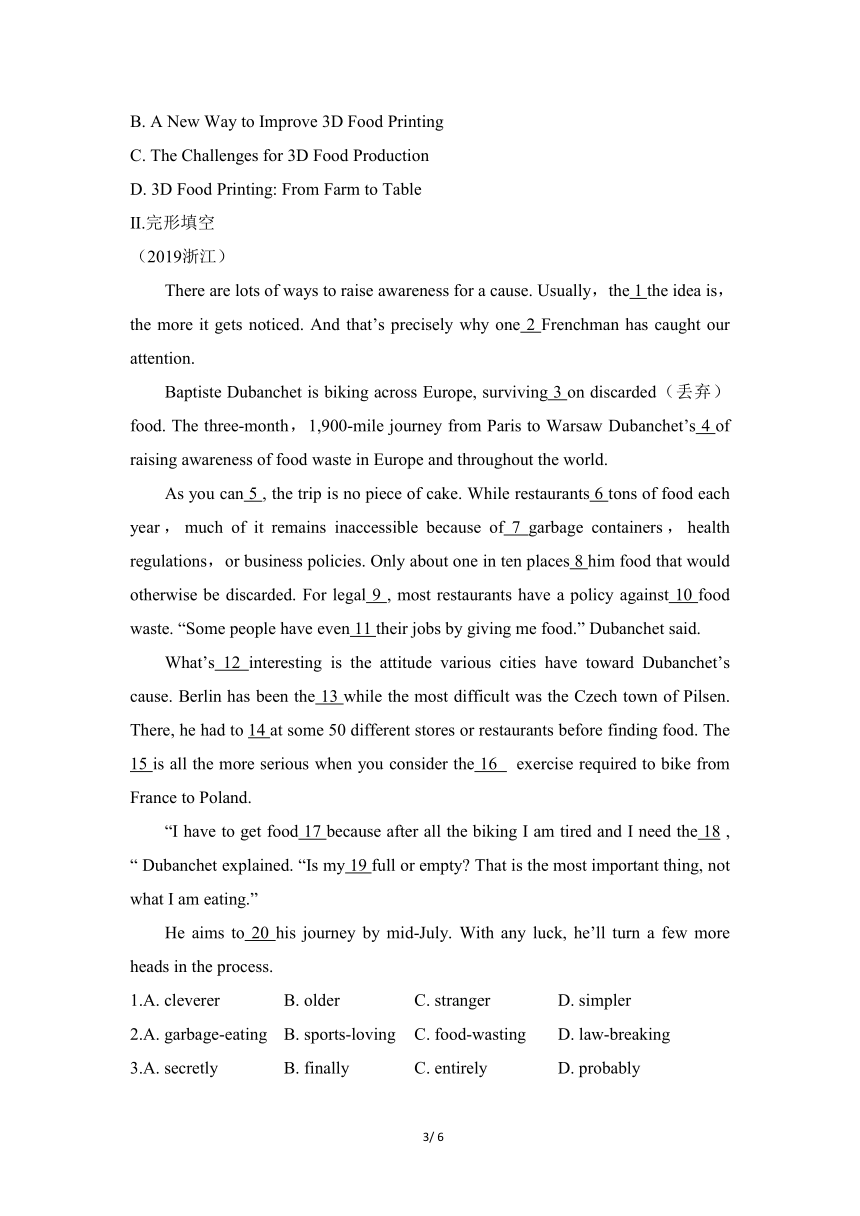人教版(2019)高中英语选择性必修第二册 Unit3 Food and Culture五年高考练(有答案)
文档属性
| 名称 | 人教版(2019)高中英语选择性必修第二册 Unit3 Food and Culture五年高考练(有答案) |  | |
| 格式 | doc | ||
| 文件大小 | 50.5KB | ||
| 资源类型 | 教案 | ||
| 版本资源 | 人教版(2019) | ||
| 科目 | 英语 | ||
| 更新时间 | 2023-03-12 15:51:38 | ||
图片预览



文档简介
Unit3 五年高考练
I.阅读理解
(2018天津,C)
There’s a new frontier in 3D printing that’s beginning to come into focus:food. Recent development has made possible machines that print, cook, and serve foods on a mass scale. And the industry isn’t stopping there.
Food production
With a 3D printer,a cook can print complicated chocolate sculptures and beautiful pieces for decoration on a wedding cake. Not everybody can do that—it takes years of experience,but a printer makes it easy. A restaurant in Spain uses a Foodini to “re-create forms and pieces” of food that are “exactly the same,” freeing cooks to complete other tasks. In another restaurant, all of the dishes and desserts it serves are 3D-printed,rather than farm to table.
Sustainability(可持续性)
The global population is expected to grow to 9.6 billion by 2050,and some analysts estimate that food production will need to be raised by 50 percent to maintain current levels. Sustainability is becoming a necessity. 3D food printing could probably contribute to the solution. Some experts believe printers could use hydrocolloids(水解胶体)from plentiful renewables like algae(藻类)and grass to replace the familiar ingredients(烹饪原料). 3D printing can reduce fuel use and emissions. Grocery stores of the future might stock “food” that lasts years on end, freeing up shelf space and reducing transportation and storage requirements.
Nutrition
Future 3D food printers could make processed food healthier. Hod Lipson,a professor at Columbia University,said, “Food printing could allow consumers to print food with customized nutritional content,like vitamins. So instead of eating a piece of yesterday’s bread from the supermarket,you’d eat something baked just for you on demand.”
Challenges
Despite recent advancements in 3D food printing,the industry has many challenges to overcome. Currently,most ingredients must be changed to a paste(糊状物)before a printer can use them,and the printing process is quite time-consuming,because ingredients interact with each other in very complex ways. On top of that,most of the 3D food printers now are restricted to dry ingredients because meat and milk products may easily go bad. Some experts are skeptical about 3D food printers,believing they are better suited for fast food restaurants than homes and high-end restaurants.
1.What benefit does 3D printing bring to food production
A. It helps cooks to create new dishes.
B. It saves time and effort in cooking.
C. It improves the cooking conditions.
D. It contributes to restaurant decorations
2. What can we learn about 3D food printing from Paragraph 3
A. It solves food shortages easily.
B. It quickens the transportation of food.
C. It needs no space for the storage of food.
D. It uses renewable materials as sources of food.
3. According to Paragraph 4, 3D-printed food _____.
A. is more available to consumers
B. can meet individual nutritional needs
C. is tastier than food in supermarkets
D. can keep all the nutrition in raw materials
4. What is the main factor that prevents 3D food printing from spreading widely
A. The printing process is complicated.
B. 3D food printers are too expensive.
C. Food materials have to be dry.
D. Some experts doubt 3D food printing
5. What could be the best title of the passage
A.3D Food Printing: Delicious New Technology
B. A New Way to Improve 3D Food Printing
C. The Challenges for 3D Food Production
D. 3D Food Printing: From Farm to Table
Ⅱ.完形填空
(2019浙江)
There are lots of ways to raise awareness for a cause. Usually,the 1 the idea is,the more it gets noticed. And that’s precisely why one 2 Frenchman has caught our attention.
Baptiste Dubanchet is biking across Europe, surviving 3 on discarded(丢弃)food. The three-month,1,900-mile journey from Paris to Warsaw Dubanchet’s 4 of raising awareness of food waste in Europe and throughout the world.
As you can 5 , the trip is no piece of cake. While restaurants 6 tons of food each year,much of it remains inaccessible because of 7 garbage containers,health regulations,or business policies. Only about one in ten places 8 him food that would otherwise be discarded. For legal 9 , most restaurants have a policy against 10 food waste. “Some people have even 11 their jobs by giving me food.” Dubanchet said.
What’s 12 interesting is the attitude various cities have toward Dubanchet’s cause. Berlin has been the 13 while the most difficult was the Czech town of Pilsen. There, he had to 14 at some 50 different stores or restaurants before finding food. The 15 is all the more serious when you consider the 16 exercise required to bike from France to Poland.
“I have to get food 17 because after all the biking I am tired and I need the 18 , “ Dubanchet explained. “Is my 19 full or empty That is the most important thing, not what I am eating.”
He aims to 20 his journey by mid-July. With any luck, he’ll turn a few more heads in the process.
1.A. cleverer B. older C. stranger D. simpler
2.A. garbage-eating B. sports-loving C. food-wasting D. law-breaking
3.A. secretly B. finally C. entirely D. probably
4.A. purpose B. way C. opinion D. dream
5.A. observe B. imagine C. suggest D. remember
6.A. store B. cook C. shop for D. throw away
7.A. locked B. damaged C. connected D. abandoned
8.A. bought B. offered C. ordered D. sold
9.A. reasons B. rights C. fees D. aids
10.A. begging for B. giving away C. hiding D. causing
11.A. did B. kept C. accepted D. risked
12.A. hardly B. usually C. particularly D. merely
13.A. easiest B. nearest C. biggest D. richest
14.A. work B. shout C. ask D. jump
15.A. competition B. conversation C. conflict D. challenge
16.A. adequate B. rewarding C. demanding D. suitable
17.A. again B. alone C. later D. fast
18.A. spirit B. energy C. time D. effort
19.A. stomach B. hand C. pocket D. basket
20.A. arrange B. restart C. report D. finish
参考答案及解析:
Ⅰ.语篇解读:本文是一篇说明文。文章介绍了3D打印技术在食品领域的应用。它可以节省时间,减少制作食物付出的努力,增加食物供应的持续性,增加食品营养的个性化,当然也面临着很多挑战。
1.B 推理判断题。根据第一段中关键信息 on a mass scale(大量地)和第二段第二句话(不是每一个人都能做到那一点,它需要花费数年的经验,但是一台打印机使它变得简单)可知,在制作食物时3D打印技术可以节省时间,减少制作食物付出的努力,故选B项。
2.D 细节理解题。根据第三段第四句(一些专家认为打印机能够使用从像藻类和草等丰富的可再生资源中获得的水解胶体来代替熟悉的烹饪原料)可确定答案为D项。
3.B 推理判断题。根据第四段直接引语中的第一句话(食物打印能使客户打印含有定制的有营养的比如维他命的内容的食物)可确定答案为B项。
4.C 细节理解题。根据最后一段第三句话(除了那一点以外,绝大部分3D食物打印机现在局限于干燥的原料,因为肉和牛奶产品可能容易变质)可确定答案为C项。
5.A 主旨大意题。文章第一句为主题句,它告诉我们文章的主题为3D打印技术的新领域——食品,接下来主要介绍了这一应用的优点,也提及了它面临的挑战。故选A项。
Ⅱ.语篇解读:本文是一篇记叙文。主题语境为人与社会,主题语境内容为公益事业。一个法国人为了提高人们对全球食物浪费问题的意识,有了一个奇怪的想法:在骑自行车穿越欧洲时只吃被丢弃的食物。本文旨在培养学生的文化意识。
1.C 考查形容词。根据后文描述可知,这个人在骑自行车穿越欧洲时只吃被丢弃的食物以引起人们对食物浪费问题的关注,这个想法是十分奇特的。句意:通常情况下,想法越奇特(stranger),它得到的关注就越多。A:更聪明;B:更老;D:更简单。
2.A 考查形容词。由第二段第一句话可知,他这一路上是靠吃被丢弃的食物生存下来的。由此可知,他是一个吃垃圾的(garbage-eating)法国人。B:喜爱运动的;C:浪费食物的;D:违法的。
3.C 考查副词。他骑车穿越欧洲,完全(entirely)靠吃被丢弃的食物生存。A:秘密地;B:最后;终于;D:很可能。
4.B 考查名词。way of doing sth做某事的方式。A:目的;意图;C:观点;主张;D:梦想。
5.B 考查动词。句意:正如你能想象到(Imagine)的那样,这趟旅行可不是一件轻而易举的事。A:观察;遵守;庆祝;C:建议;表明;D:记住;牢记。
6.D 考查动词(短语)。尽管每年饭店会扔掉(throw away)许多食物,但是其中的大部分人们是得不到的。A:储存;储藏B:烹调;C:采购。
7.A 考查形容词。人们得不到被扔掉的食物的一个原因就是盛放这些食物的容器被锁上了,故选A项。B:被损坏的C:连接的;D:被遗弃的。
8.B 考查动词。句意:只有大约十分之一的地方会给他提供(offered)食物。要不然这些食物就会被丢弃。A:买;C:点菜;命令;D:卖。
9.A 考查名词。句意:因为法律方面的原因(reasons),大多数饭店都有一个反对赠送餐厨垃圾的政策。B:权利;C:费用;D:帮助;援助。
10.B 考查非谓语动词。此处表示饭店反对把剩下的食物赠送(gIving away)给别人,故选B项。A:祈求;C:隐藏;D:导致,引起。
11.D 考查动词。此处表示“有些人甚至会冒着丢掉工作的危险(risked)给我食物”。A:做;B:保持;保存;C:接受。
12.C 考查副词。句意:特别(particularly)有趣的事是不同的城市对待 Dubanchet的事业的态度。A:几乎不;B:通常;D:仅仅。
13.A 考查形容词。柏林是最容易(easiest)得到食物的城市而捷克的比尔森市是最难得到食物的城市。the easiest与the most difficult对应。B:最近的;C:最大的;D:最富有的。
14.C 考查动词。在那里,他不得不询问大约50家不同的商店或者饭店才能找到食物。A:工作;B:呼喊;喊叫;D:跳起来。
15.D 考查名词。上文描述了向商店或饭店要剩下的食物所遇到的困难,再加上骑车穿越欧洲,挑战(challenge)就更严峻了。A:竞赛;比赛;B:对话;交谈;C:矛盾;冲突。
16.C 考查形容词。骑车从巴黎到波兰对体能要求很高(demanding)。A:充足的;B:有益的;值得做的;D适当的。
17.D 考查副词。在“我”骑车长途跋涉后,“我”必须很快(fast)得到吃的东西。A:再次;又;B:单独;独自;C:后来。
18.B 考查名词。因为在长途骑行后“我”很疲惫,所以需要从食物中得到能量(energy)。A:精神;心灵;C:时间D:努力。
19.A 考查名词。“我”只关心“我”的胃(stomach)里有没有东西,不关心“我”吃的是什么。
20.D 考查动词。句意:他的目标是在7月中旬之前完成(finish)这次旅程。A:安排;B:重新开始;C:报道。
I.阅读理解
(2018天津,C)
There’s a new frontier in 3D printing that’s beginning to come into focus:food. Recent development has made possible machines that print, cook, and serve foods on a mass scale. And the industry isn’t stopping there.
Food production
With a 3D printer,a cook can print complicated chocolate sculptures and beautiful pieces for decoration on a wedding cake. Not everybody can do that—it takes years of experience,but a printer makes it easy. A restaurant in Spain uses a Foodini to “re-create forms and pieces” of food that are “exactly the same,” freeing cooks to complete other tasks. In another restaurant, all of the dishes and desserts it serves are 3D-printed,rather than farm to table.
Sustainability(可持续性)
The global population is expected to grow to 9.6 billion by 2050,and some analysts estimate that food production will need to be raised by 50 percent to maintain current levels. Sustainability is becoming a necessity. 3D food printing could probably contribute to the solution. Some experts believe printers could use hydrocolloids(水解胶体)from plentiful renewables like algae(藻类)and grass to replace the familiar ingredients(烹饪原料). 3D printing can reduce fuel use and emissions. Grocery stores of the future might stock “food” that lasts years on end, freeing up shelf space and reducing transportation and storage requirements.
Nutrition
Future 3D food printers could make processed food healthier. Hod Lipson,a professor at Columbia University,said, “Food printing could allow consumers to print food with customized nutritional content,like vitamins. So instead of eating a piece of yesterday’s bread from the supermarket,you’d eat something baked just for you on demand.”
Challenges
Despite recent advancements in 3D food printing,the industry has many challenges to overcome. Currently,most ingredients must be changed to a paste(糊状物)before a printer can use them,and the printing process is quite time-consuming,because ingredients interact with each other in very complex ways. On top of that,most of the 3D food printers now are restricted to dry ingredients because meat and milk products may easily go bad. Some experts are skeptical about 3D food printers,believing they are better suited for fast food restaurants than homes and high-end restaurants.
1.What benefit does 3D printing bring to food production
A. It helps cooks to create new dishes.
B. It saves time and effort in cooking.
C. It improves the cooking conditions.
D. It contributes to restaurant decorations
2. What can we learn about 3D food printing from Paragraph 3
A. It solves food shortages easily.
B. It quickens the transportation of food.
C. It needs no space for the storage of food.
D. It uses renewable materials as sources of food.
3. According to Paragraph 4, 3D-printed food _____.
A. is more available to consumers
B. can meet individual nutritional needs
C. is tastier than food in supermarkets
D. can keep all the nutrition in raw materials
4. What is the main factor that prevents 3D food printing from spreading widely
A. The printing process is complicated.
B. 3D food printers are too expensive.
C. Food materials have to be dry.
D. Some experts doubt 3D food printing
5. What could be the best title of the passage
A.3D Food Printing: Delicious New Technology
B. A New Way to Improve 3D Food Printing
C. The Challenges for 3D Food Production
D. 3D Food Printing: From Farm to Table
Ⅱ.完形填空
(2019浙江)
There are lots of ways to raise awareness for a cause. Usually,the 1 the idea is,the more it gets noticed. And that’s precisely why one 2 Frenchman has caught our attention.
Baptiste Dubanchet is biking across Europe, surviving 3 on discarded(丢弃)food. The three-month,1,900-mile journey from Paris to Warsaw Dubanchet’s 4 of raising awareness of food waste in Europe and throughout the world.
As you can 5 , the trip is no piece of cake. While restaurants 6 tons of food each year,much of it remains inaccessible because of 7 garbage containers,health regulations,or business policies. Only about one in ten places 8 him food that would otherwise be discarded. For legal 9 , most restaurants have a policy against 10 food waste. “Some people have even 11 their jobs by giving me food.” Dubanchet said.
What’s 12 interesting is the attitude various cities have toward Dubanchet’s cause. Berlin has been the 13 while the most difficult was the Czech town of Pilsen. There, he had to 14 at some 50 different stores or restaurants before finding food. The 15 is all the more serious when you consider the 16 exercise required to bike from France to Poland.
“I have to get food 17 because after all the biking I am tired and I need the 18 , “ Dubanchet explained. “Is my 19 full or empty That is the most important thing, not what I am eating.”
He aims to 20 his journey by mid-July. With any luck, he’ll turn a few more heads in the process.
1.A. cleverer B. older C. stranger D. simpler
2.A. garbage-eating B. sports-loving C. food-wasting D. law-breaking
3.A. secretly B. finally C. entirely D. probably
4.A. purpose B. way C. opinion D. dream
5.A. observe B. imagine C. suggest D. remember
6.A. store B. cook C. shop for D. throw away
7.A. locked B. damaged C. connected D. abandoned
8.A. bought B. offered C. ordered D. sold
9.A. reasons B. rights C. fees D. aids
10.A. begging for B. giving away C. hiding D. causing
11.A. did B. kept C. accepted D. risked
12.A. hardly B. usually C. particularly D. merely
13.A. easiest B. nearest C. biggest D. richest
14.A. work B. shout C. ask D. jump
15.A. competition B. conversation C. conflict D. challenge
16.A. adequate B. rewarding C. demanding D. suitable
17.A. again B. alone C. later D. fast
18.A. spirit B. energy C. time D. effort
19.A. stomach B. hand C. pocket D. basket
20.A. arrange B. restart C. report D. finish
参考答案及解析:
Ⅰ.语篇解读:本文是一篇说明文。文章介绍了3D打印技术在食品领域的应用。它可以节省时间,减少制作食物付出的努力,增加食物供应的持续性,增加食品营养的个性化,当然也面临着很多挑战。
1.B 推理判断题。根据第一段中关键信息 on a mass scale(大量地)和第二段第二句话(不是每一个人都能做到那一点,它需要花费数年的经验,但是一台打印机使它变得简单)可知,在制作食物时3D打印技术可以节省时间,减少制作食物付出的努力,故选B项。
2.D 细节理解题。根据第三段第四句(一些专家认为打印机能够使用从像藻类和草等丰富的可再生资源中获得的水解胶体来代替熟悉的烹饪原料)可确定答案为D项。
3.B 推理判断题。根据第四段直接引语中的第一句话(食物打印能使客户打印含有定制的有营养的比如维他命的内容的食物)可确定答案为B项。
4.C 细节理解题。根据最后一段第三句话(除了那一点以外,绝大部分3D食物打印机现在局限于干燥的原料,因为肉和牛奶产品可能容易变质)可确定答案为C项。
5.A 主旨大意题。文章第一句为主题句,它告诉我们文章的主题为3D打印技术的新领域——食品,接下来主要介绍了这一应用的优点,也提及了它面临的挑战。故选A项。
Ⅱ.语篇解读:本文是一篇记叙文。主题语境为人与社会,主题语境内容为公益事业。一个法国人为了提高人们对全球食物浪费问题的意识,有了一个奇怪的想法:在骑自行车穿越欧洲时只吃被丢弃的食物。本文旨在培养学生的文化意识。
1.C 考查形容词。根据后文描述可知,这个人在骑自行车穿越欧洲时只吃被丢弃的食物以引起人们对食物浪费问题的关注,这个想法是十分奇特的。句意:通常情况下,想法越奇特(stranger),它得到的关注就越多。A:更聪明;B:更老;D:更简单。
2.A 考查形容词。由第二段第一句话可知,他这一路上是靠吃被丢弃的食物生存下来的。由此可知,他是一个吃垃圾的(garbage-eating)法国人。B:喜爱运动的;C:浪费食物的;D:违法的。
3.C 考查副词。他骑车穿越欧洲,完全(entirely)靠吃被丢弃的食物生存。A:秘密地;B:最后;终于;D:很可能。
4.B 考查名词。way of doing sth做某事的方式。A:目的;意图;C:观点;主张;D:梦想。
5.B 考查动词。句意:正如你能想象到(Imagine)的那样,这趟旅行可不是一件轻而易举的事。A:观察;遵守;庆祝;C:建议;表明;D:记住;牢记。
6.D 考查动词(短语)。尽管每年饭店会扔掉(throw away)许多食物,但是其中的大部分人们是得不到的。A:储存;储藏B:烹调;C:采购。
7.A 考查形容词。人们得不到被扔掉的食物的一个原因就是盛放这些食物的容器被锁上了,故选A项。B:被损坏的C:连接的;D:被遗弃的。
8.B 考查动词。句意:只有大约十分之一的地方会给他提供(offered)食物。要不然这些食物就会被丢弃。A:买;C:点菜;命令;D:卖。
9.A 考查名词。句意:因为法律方面的原因(reasons),大多数饭店都有一个反对赠送餐厨垃圾的政策。B:权利;C:费用;D:帮助;援助。
10.B 考查非谓语动词。此处表示饭店反对把剩下的食物赠送(gIving away)给别人,故选B项。A:祈求;C:隐藏;D:导致,引起。
11.D 考查动词。此处表示“有些人甚至会冒着丢掉工作的危险(risked)给我食物”。A:做;B:保持;保存;C:接受。
12.C 考查副词。句意:特别(particularly)有趣的事是不同的城市对待 Dubanchet的事业的态度。A:几乎不;B:通常;D:仅仅。
13.A 考查形容词。柏林是最容易(easiest)得到食物的城市而捷克的比尔森市是最难得到食物的城市。the easiest与the most difficult对应。B:最近的;C:最大的;D:最富有的。
14.C 考查动词。在那里,他不得不询问大约50家不同的商店或者饭店才能找到食物。A:工作;B:呼喊;喊叫;D:跳起来。
15.D 考查名词。上文描述了向商店或饭店要剩下的食物所遇到的困难,再加上骑车穿越欧洲,挑战(challenge)就更严峻了。A:竞赛;比赛;B:对话;交谈;C:矛盾;冲突。
16.C 考查形容词。骑车从巴黎到波兰对体能要求很高(demanding)。A:充足的;B:有益的;值得做的;D适当的。
17.D 考查副词。在“我”骑车长途跋涉后,“我”必须很快(fast)得到吃的东西。A:再次;又;B:单独;独自;C:后来。
18.B 考查名词。因为在长途骑行后“我”很疲惫,所以需要从食物中得到能量(energy)。A:精神;心灵;C:时间D:努力。
19.A 考查名词。“我”只关心“我”的胃(stomach)里有没有东西,不关心“我”吃的是什么。
20.D 考查动词。句意:他的目标是在7月中旬之前完成(finish)这次旅程。A:安排;B:重新开始;C:报道。
